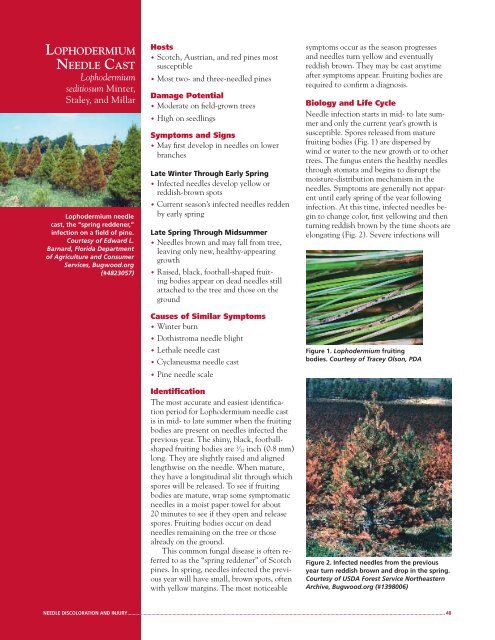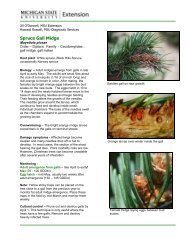Integrated Pest Management for Christmas Tree Production: A ...
Integrated Pest Management for Christmas Tree Production: A ...
Integrated Pest Management for Christmas Tree Production: A ...
Create successful ePaper yourself
Turn your PDF publications into a flip-book with our unique Google optimized e-Paper software.
LOPHODERMIUM<br />
NEEDLE CAST<br />
Lophodermium<br />
seditiosum Minter,<br />
Staley, and Millar<br />
Lophodermium needle<br />
cast, the “spring reddener,”<br />
infection on a fi eld of pine.<br />
Courtesy of Edward L.<br />
Barnard, Florida Department<br />
of Agriculture and Consumer<br />
Services, Bugwood.org<br />
(#4823057)<br />
Hosts<br />
• Scotch, Austrian, and red pines most<br />
susceptible<br />
• Most two- and three-needled pines<br />
Damage Potential<br />
• Moderate on fi eld-grown trees<br />
• High on seedlings<br />
Symptoms and Signs<br />
• May fi rst develop in needles on lower<br />
branches<br />
Late Winter Through Early Spring<br />
• Infected needles develop yellow or<br />
reddish-brown spots<br />
• Current season’s infected needles redden<br />
by early spring<br />
Late Spring Through Midsummer<br />
• Needles brown and may fall from tree,<br />
leaving only new, healthy-appearing<br />
growth<br />
• Raised, black, football-shaped fruiting<br />
bodies appear on dead needles still<br />
attached to the tree and those on the<br />
ground<br />
Causes of Similar Symptoms<br />
• Winter burn<br />
• Dothistroma needle blight<br />
• Lethale needle cast<br />
• Cyclaneusma needle cast<br />
• Pine needle scale<br />
Identifi cation<br />
The most accurate and easiest identifi cation<br />
period <strong>for</strong> Lophodermium needle cast<br />
is in mid- to late summer when the fruiting<br />
bodies are present on needles infected the<br />
previous year. The shiny, black, footballshaped<br />
fruiting bodies are 1 ⁄32 inch (0.8 mm)<br />
long. They are slightly raised and aligned<br />
lengthwise on the needle. When mature,<br />
they have a longitudinal slit through which<br />
spores will be released. To see if fruiting<br />
bodies are mature, wrap some symptomatic<br />
needles in a moist paper towel <strong>for</strong> about<br />
20 minutes to see if they open and release<br />
spores. Fruiting bodies occur on dead<br />
needles remaining on the tree or those<br />
already on the ground.<br />
This common fungal disease is often referred<br />
to as the “spring reddener” of Scotch<br />
pines. In spring, needles infected the previous<br />
year will have small, brown spots, often<br />
with yellow margins. The most noticeable<br />
symptoms occur as the season progresses<br />
and needles turn yellow and eventually<br />
reddish brown. They may be cast anytime<br />
after symptoms appear. Fruiting bodies are<br />
required to confi rm a diagnosis.<br />
Biology and Life Cycle<br />
Needle infection starts in mid- to late summer<br />
and only the current year’s growth is<br />
susceptible. Spores released from mature<br />
fruiting bodies (Fig. 1) are dispersed by<br />
wind or water to the new growth or to other<br />
trees. The fungus enters the healthy needles<br />
through stomata and begins to disrupt the<br />
moisture-distribution mechanism in the<br />
needles. Symptoms are generally not apparent<br />
until early spring of the year following<br />
infection. At this time, infected needles begin<br />
to change color, fi rst yellowing and then<br />
turning reddish brown by the time shoots are<br />
elongating (Fig. 2). Severe infections will<br />
Figure 1. Lophodermium fruiting<br />
bodies. Courtesy of Tracey Olson, PDA<br />
Figure 2. Infected needles from the previous<br />
year turn reddish brown and drop in the spring.<br />
Courtesy of USDA Forest Service Northeastern<br />
Archive, Bugwood.org (#1398006)<br />
NEEDLE DISCOLORATION AND INJURY .......... ................................................................................................................................................................................................................................................ 48





